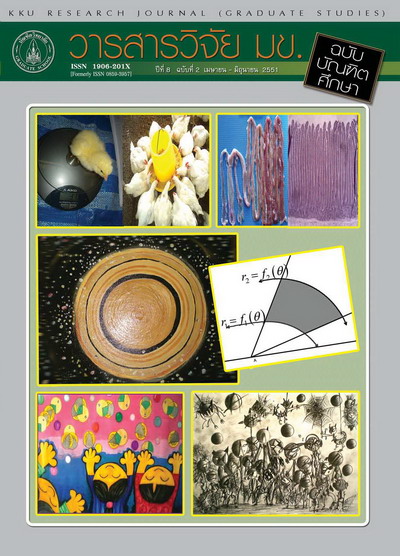The Impact of Different Types of Teacher Written Feedback on EFL University Studentsû Writing(ผลกระทบของการให้ผลสะท้อนกลับโดยการเขียนของครูชนิดต่างๆ ที่มีต่อการเขียนของนักศึกษาระดับอุดมศึกษาที่เรียนภาษาอังกฤษเป็นภาษาต่างประเทศ)
Keywords:
Teacher written feedback(การให้ผลสะท้อนกลับโดยการเขียนของครู), Error correction(ข้อผิดพลาดด้านการเขียน)Abstract
This experimental study aims to investigate teacher written feedback with different degrees of explicitness of error correction namely, direct, coded, and uncoded feedback. These three types of feedback were given to 81 EFL major students enrolled in a 14-week paragraph writing course using a process approach in a Thai university. The students wrote paragraphs of three different genres (narration, description, and comparison and contrast) with three topics and three drafts for each genre. A total of 1,458 second drafts and final drafts were compared to see the improvement of student writing (holistic writing, targeted linguistic errors, and length of writing. Paired Sample T-Test reveals a highly significant improvement in the students’ holistic writing and reduction of errors, but there was no significant difference in the length of writing in comparing first and last writing. The result of error analysis shows that the highest error rate was found in wrong word followed by sentence structure, verb, article, and noun ending respectively.งานวิจัยครั้งนี้เป็นการวิจัยเชิงทดลองโดยมีวัตถุประสงค์เพื่อการศึกษาให้ผลสะท้อนกลับโดยการเขียนของครูชนิดต่างๆ คือ การให้ผลสะท้อนกลับแบบตรง (direct feedback) แบบรหัส (coded feedback) แบบขีดเส้นใต้(uncoded feedback) โดยในการทดลองมีการให้ผลสะท้อนทั้งสามชนิดแก่นักศึกษาวิชาเอกภาษาอังกฤษ จำนวน 81 คนที่เรียนในรายวิชาการเขียนย่อหน้า โดยใช้วิธีการสอนแบบเน้นกระบวนการเขียน ตลอดช่วงระยะเวลา14 สัปดาห์ การเขียนย่อหน้าของนักศึกษาประกอบด้วย 3รูปแบบอันได้แก่การเล่าเรื่อง (narration)
การบรรยายความ(description) และการเปรียบเทียบ(comparison and contrast) โดยนักศึกษาได้รับมอบหมายงานให้เขียนตาม3 รูปแบบดังกล่าว จำนวนรูแปบบละ 3 หัวข้อและในแต่ละหัวข้อนักศึกษาต้องเขียนฉบับร่าง(draft)3 ฉบับ โดยผู้วิจัยได้ทำการวิเคราะห์ข้อมูลซึ่งได้มาจากการเปรียบเทียบการเขียนฉบับร่างที่2 (second draft)และฉบับสุดท้าย(final draft) จำนวน1,458 ฉบับ เพื่อตรวจสอบการพัฒนาทางการเขียนของนักศึกษา(คุณภาพข้อผิดพลาดในการเขียน และความยาวของเรื่อง) ผลการวิจัยพบว่านักศึกษามีการพัฒนาคุณภาพของการเขียนมากขึ้นและข้อผิดพลาดในการเขียนลดลงอย่างมีนัยสำคัญทางสถิติ แต่จำนวนคำในการเขียนไม่ได้เพิ่มขึ้นผลของการวิเคราะห์ข้อผิดพลาดด้านการเขียนของนักศึกษาพบว่า ข้อผิดพลาดที่พบมากที่สุดคือการใช้คำผิดรองลงมาคือโครงสร้างประโยค คำกริยา คำนำหน้านาม และส่วนเติมท้ายคำนาม ตามลำดับ



